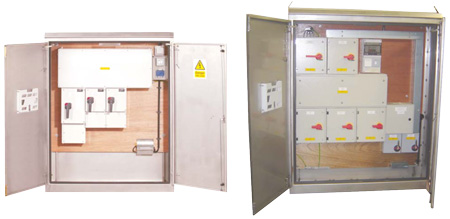
|
|
| home | contact | team t&d | group websites | markets | exports | blog |
 |
|
Abelco DNO & FSP Feeder Pillars - Trackside Rail Solutions Supply Cubicles
By Chris Dodds on 24th August, 2012

Rail Feeder Pillars LV Electricity Distribution
A-Belco Trackside Rail Solutions - DNO & FSP Supply Cubicles
A-Belco Stainless Steel Feeder Pillars and Cubicles are Network Rail NR/SP/ELP/40045 Issue 5 approved and are used to provide low voltage electricity distribution to trackside signalling systems, lighting and points. The feeder pillars are single or double sided depending on trackside restriction for meter readings.
Two types of feeder pillar are available:
- DNO feeder pillar for trackside power supply and distribution
- FSP feeder pillar for signalling and point heating systems

| Enclosure |
316L Stainless Steel |
| Internal Enclosures |
Mild steel GRP |
| Encapsulation |
Pretroleum Jelly |
| IP Rating |
IP54 |
| Cable Entries |
Bottom |
| Access |
At Front |
| Busbars |
Horizontal, allowing future extension |
| Voltage |
5 phase (230V Ac) or 3 phase + N (400V) |
| Current Ratings |
100A, 200A, 400A (higher ratings upon request) |
| Isolators |
From 32A to 800A, 3 or 4 pole |
| Fuse Switches |
From 32A to 800A, 3 or 4 pole Fused Combination Switches |
| Fault Rating |
Maximum 36kA for 1 second |
- Further Reading
Invitation
Thorne & Derrick are inviting you to join LinkedIn’s fastest growing Discussion Group : Low & High Voltage Power, Cabling, Jointing, & Hazardous Area Electricals (LV-HV).
Discussion subjects include cable installations, cable jointing, electrical substation, overhead line and electrical construction at LV, 11kV, 33kV and EHV.
Network, engage and promote your profile, company or products with over 10,000 influencers.
 | Abelco Feeder Pillars - Network Rail Approved for Trackside Power & Signalling Systems |
Category: Power Distribution & Feeder Pillars
Sort by Category:
- #ThrowBackThursday
- 3M Scotch Tapes
- ABB Power Products
- Business
- Cable Accessories
- Cable Cleats & Cable Ties
- Cable Containment LV HV
- Cable Crimping & Cutting Tools
- Cable Jointer Training Courses
- Cable Jointing - PhotoBlog
- Cable Labelling & Marking
- Cable Laying & Cable Pulling
- Cable Transits & Duct Sealing
- Company Updates
- Earthing & Lightning Protection
- Electrical Equipment HV
- Electrical Equipment LV
- Electrical Safety & Arc Flash
- Exports
- Flexible Conduit Cable Management
- Hazardous Area Electricals & Lighting
- HV Cable Jointing & Terminating
- LV Cable Jointing & Terminating
- Nexans Euromold Cable Accessories
- Plugs & Sockets
- Power Distribution & Feeder Pillars
- Prysmian FP Cables
- PV Solar Farms
- Rail
- T&D History Blog
- Terms & Conditions of Sale & Purchase
Tweets by @ThorneanDerrick






























